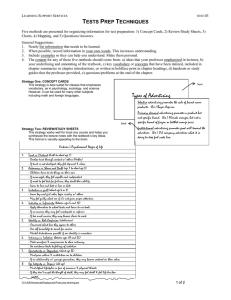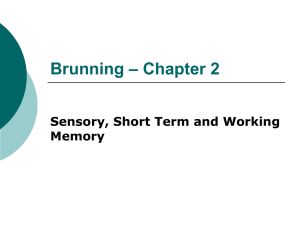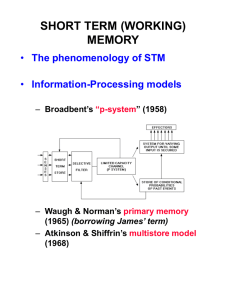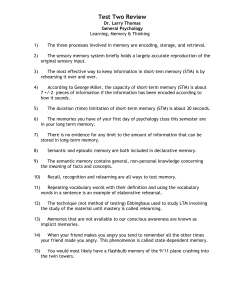Read: Sacks for Thursday Loftus for Tuesday Vokey for Thursday
advertisement
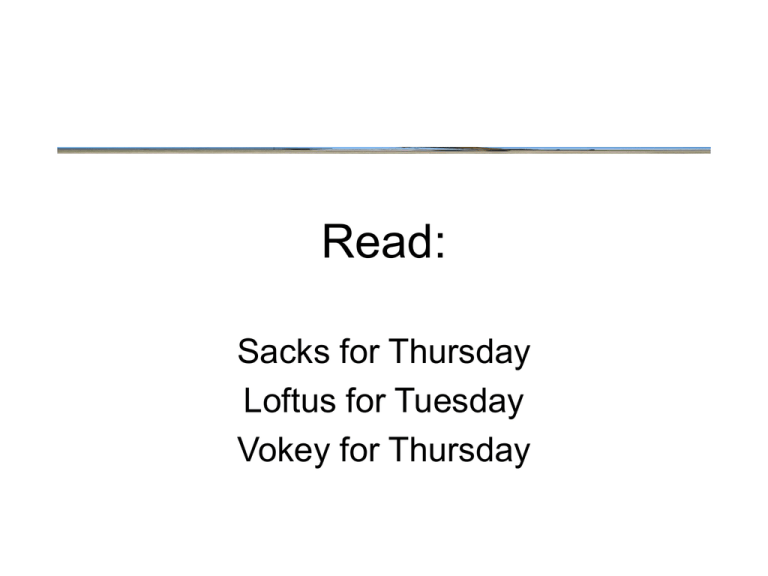
Read: Sacks for Thursday Loftus for Tuesday Vokey for Thursday Iconic Memory • a brief storage of “raw data” in the visual system Echoic Memory • Auditory information is stored in a similar sensory “buffer” – Echoic memory seems to last for several seconds Properties of Sensory Memory 1. Brief (iconic ~500ms; echoic ~2 seconds) Properties of Sensory Memory 1. Brief (iconic ~500ms; echoic ~2 seconds) 2. Virtually unlimited capacity Properties of Sensory Memory 1. Brief (iconic ~500ms; echoic ~2 seconds) 2. Virtually unlimited capacity 3. pre-attentive Overview of Memory RETRIEVAL • Atkinson-Shiffrin Model ATTENTION Sensory Signals Sensory Memory Short-Term Memory Long-Term Memory REHEARSAL Short-Term Memory • process by which we hold information “in mind” Short-Term Memory • process by which we hold information “in mind” • example: temporarily remembering a phone number Characteristics of STM • Duration? Capacity? • How could one measure these parameters? Characteristics of STM • Limited Duration – Brown-Petersen Task: • subject is given a trigram (e.g. C-F-W) to remember • vocal rehearsal is prevented by counting backwards • recall accuracy tested as a function of retention interval Characteristics of STM • STM decays over seconds Characteristics of STM • Limited Duration – Brown-Petersen Task Interpretation: rapid loss of information in STM (over a period of seconds…much longer than sensory memory) Characteristics of STM • Limited Capacity – How might you measure capacity? Characteristics of STM • Limited Capacity – George Miller – Subject is given longer and longer lists of to-be-remembered items (words, characters, digits) Characteristics of STM • Limited Capacity – George Miller – Subject is given longer and longer lists of to-be-remembered items (words, characters, digits) – Result: Subjects are successful up to about 7 items Characteristics of STM • Limited Capacity – What confound must be considered ?! Characteristics of STM • Limited Capacity – What confound must be considered ?! – Recalling takes time ! Characteristics of STM • Limited Capacity – What confound must be considered ?! – Recalling takes time ! – It seems that the “capacity” of STM (at least measured in this way) depends on the rate of speech - faster speech leads to apparently larger capacity – Some believe capacity is “2 - 3 seconds worth of speech” Forgetting from STM • Why do we “forget” from STM? – Does the memory trace decay? • not likely because with very small lists (like 1 item) retention is high for long intervals Forgetting from STM • Why do we “forget” from STM? – Does the memory trace decay? • not likely because with very small lists (like 1 item) retention is high for long intervals – Instead, it seems that information “piles up” and begins to interfere Forgetting from STM • Interference in STM is complex and specific Forgetting from STM • Interference in STM is complex and specific • For example, severity of interference depends on meaning Forgetting from STM • Interference in STM is complex and specific • For example, severity of interference depends on meaning – Subjects are given successive recall tasks with list items from the same category (e.g. fruits) – final list is of either same or different category - how is good is recall on this list? Forgetting from STM • Accuracy rebounds if category changes Coding in STM • How is information coded in STM? Coding in STM • Clues about coding in STM: – # of items stored in STM depends on rate of speech Coding in STM • Clues about coding in STM: – # of items stored in STM depends on rate of speech – phonological similarity effect: similar sounding words are harder to store/recall than different sounding words Coding in STM • Clues about coding in STM: – # of items stored in STM depends on rate of speech – phonological similarity effect: similar sounding words are harder to store/recall than different sounding words What does this suggest about the nature of information in STM? Coding in STM • It seems that information can be stored in a linguistic or phonological form Coding in STM • It seems that information can be stored in a linguistic or phonological form Must it be stored this way? Coding in STM • It is also possible to “keep in mind” nonverbal information, such as a map Are there two different STM systems? A Modular Approach to STM Central Executive Articulatory Loop Visuospatial Sketchpad Experiment 1 in the article by Lee Brooks demonstrates a double dissociation between Articulatory Loop and Visuospatial Sketchpad Working Memory “Modules” • Lee Brooks: interference between different representations in STM (Experiment 1) – Memory Representation • verbal task: categorize words in a sentence • spatial task: categorize corners in a block letter – Response Modality • verbal response: say “yes” or “no” • spatial response: point to “yes” or “no” Working Memory “Modules” • result: Performance Verbal Representation (categorize words) Spatial Representation (categorize corners) Verbal Spatial Response Modality Working Memory “Modules” • Interpretation: – supports notion of modularity in Working Memory (visuospatial sketchpad / articulatory loop) Model of Memory RETRIEVAL Turning now to Long-Term Memory ATTENTION Sensory Signals Sensory Memory Short-Term Memory Long-Term Memory REHEARSAL Long-Term Memory • Characteristics (intuitive with some introspection): – Persists indefinitely (up to decades!) – Requires no active process of rehearsal (at least that we are conscious of) Long-Term Memory • Characteristics (intuitive with some introspection): – Persists indefinitely (up to decades!) – Requires no active process of rehearsal (at least that we are conscious of) – What are some examples of Long-Term Memories? Some Distinctions in LTM • Endel Tulving: There are two broad categories of information that are represented in LTM • Examples: – What did you eat for breakfast? – What is the capital of Canada – Where were you when… – Are maple trees deciduous? – Riding a bike !? Some Distinctions in LTM • Endel Tulving: There are two broad categories of information that are represented in LTM • Episodic Memory: memory of an event in your life • autobiographical • has a temporal context - something about time is encoded along with the memory Some Distinctions in LTM • Endel Tulving: There are two broad categories of information that are represented in LTM • Semantic Memory: memory of facts, knowledge of the world • unconnected to an autobiographical event • no temporal context Some Distinctions in LTM • A third category may be distinguished: – Example: riding a bike, playing an instrument Some Distinctions in LTM • Procedural Memory: memory for actions Semantic Memory • Capacity is huge (unlimited?) Semantic Memory • Structure of encoding is associative Semantic Memory • Structure of encoding is associative – This idea is formalized in so-called “connectionist” networks skiing highschool mockingbird bird canary chicken Mr. Lacey To Kill A Mockingbird racism English Martin Luther King When You Don’t Remember • Two reasons why you don’t remember: When You Don’t Remember • Two reasons why you don’t remember: • Unavailable – It wasn’t successfully encoded - something went wrong while you were studying When You Don’t Remember • Two reasons why you don’t remember: • Unavailable – It wasn’t successfully encoded - something went wrong while you were studying • Inaccessible – memory is stored but cannot be retrieved, perhaps because appropriate connections aren’t being made


